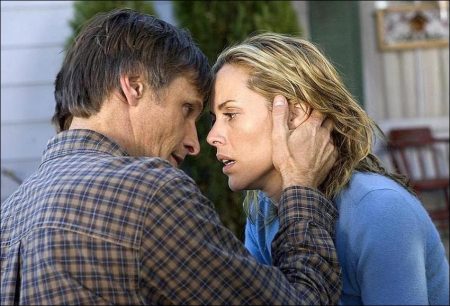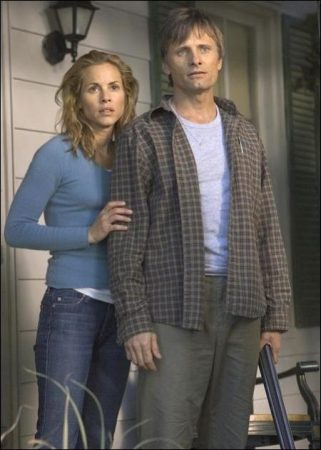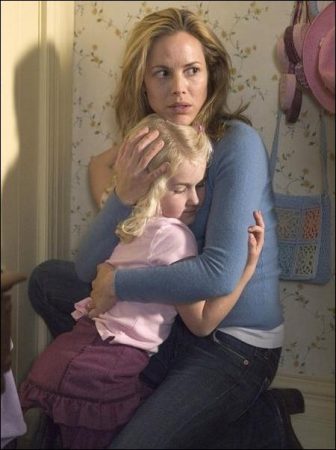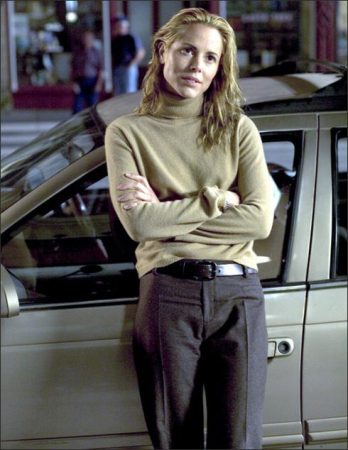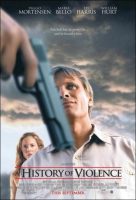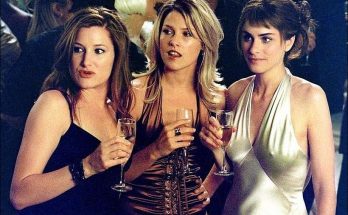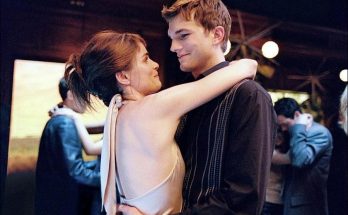Tom Stall had a perfect life… until he became a hero.
“A History of Violence” stars Viggo Mortensen as a pillar of a small town community who runs a diner and lives a happy and quiet life with his wife (Maria Bello) and two children. But their lives are forever changed when Mortensen thwarts an attempted robbery and is lauded as a hero by the media, attracting the attention of some mobsters (William Hurt and Ed Harris) who believe he is someone else.
Tom Stall (Viggo Mortensen) is living a happy and quiet life with his lawyer wife (Maria Bello) and their two children in the small town of Millbrook, Indiana, but one night their idyllic existence is shattered when Tom foils a vicious attempted robbery in his diner. Sensing danger, he takes action and saves his customers and friends in the self-defense killings of two-sought-after criminals.
Heralded as a hero, Tom’s life is changed overnight, attracting a national media circus, which forces him into the spotlight. Uncomfortable with his newfound celebrity, Tom tries to return to the normalcy of his ordinary life only to be confronted by a mysterious and threatening man (Ed Harris) who arrives in town believing Tom is the man who’s wronged him in the past.
As Tom and his family fight back against this case of mistaken identity and struggle to cope with their changed reality, they are forced to confront their relationships and the divisive issues which surface as a result.
About the Production
When Producer JC Spink read John Wagner and Vince Locke’s graphic novel A History of Violence, he immediately recognized its film potential. Spink and his producing partner Chris Bender were inspired by the internal struggle the main character faces.
The team, who has a first look deal with New Line Cinema, presented the project to the studio, which responded with enthusiasm and secured the rights. Josh Olson wrote the screenplay, which he extrapolated from the novel, published six years previously by Paradox Press, which also published Road to Perdition.
“The title was intriguing,” says Olson. “It sparked a lot of ideas. What would happen to real people in this situation was my approach.” Olson developed the characters using the book as a launching pad. “It’s a wrong-man scenario. A man must prove his innocence to a group of bad men.”
Director David Cronenberg, who joined the project in the winter of 2003, found the screenplay compelling. “Loosely based on the graphic novel, Josh’s script is a Midwest American small town story,” says Cronenberg. “There was something classic about it without being imitative.”
Adds Olson, “What really interested me about the story was taking this classic middle America family and putting them into an extreme situation, and show how it affected them – what happens when you inject violence into an ordinary, happy household.”
Although he doesn’t normally undertake family dramas, Cronenberg felt for the characters and the Stall family. “It does have a powerful emotional resonance. A married couple with two kids are trying to live an open, straightforward honest life, and finding it difficult to do that. So I fell for that classical element.”
“It’s mainstream to a certain extent, but it has some very disturbing and interesting undercurrents,” continues the director, whose unique body of work has been acclaimed around the world. “I thought it was an interesting kind of thriller, because it’s not a normal kind of thriller. It’s like a Hitchcock thriller where an innocent man is mistaken by some very scary people for someone else and drawn into a world that he’d rather not know anything about.
His life and the lives of his family are endangered because of this mistaken identity. The film clicks into several intriguing things, but then derails in a very interesting way,” observes Cronenberg, who collaborated on revisions with Olson, changing the organized crime members’ names to from Italian to Irish in order to distance them from the mafia, among other alterations.
“A lot of David’s movies have to do with identities, what’s real and what’s not,” remarks producer Chris Bender. “What ties this movie to his others is Viggo Mortensen’s character Tom Stall, who is struggling with an identity problem and questioning the reality he is living.”
“Although A History of Violence is not a typical studio film, in some broad ways, it ties in thematically with David’s interests, but it really doesn’t feel like anything he’s done before,” says screenwriter Josh Olson.
Once New Line Cinema gave the project a green light, the production set up offices in Toronto, Canada, Cronenberg’s home town where he remains loyal to his “family of collaborators” – key crew members who have worked with him over the years.
Among them is Director of Photography, Peter Suschitzky (Spider, eXistenZ), working on his seventh film with Cronenberg, who notes, “When I first read the script, I knew it was quite different and more narrative-driven than anything that David had tackled before. To encourage him to take it, I asked him to think about the movies of Fritz Lang because one of the main themes running through Lang’s movies was that of a character who can’t escape his fate – an interesting link.”
Clearly Cronenberg was hooked, as he enlisted Viggo Mortensen and Maria Bello to join the cast, his first choice to play the married Stall couple. And Ed Harris and William Hurt are among his favorite American actors with whom he’d wanted to work for years.
“I couldn’t have asked for a better cast. The tone is of seriously good acting, a profound dedication to the roles and digging deep into the characters,” observes the director. Newcomer Ashton Holmes was selected from 100 candidates who auditioned in Los Angeles and Toronto for the role of the son. Six-year old Heidi Hayes, a local discovery, completed the family group.
Rounding out the cast are Stephen McHattie (The Dark, Life with Billy) who partnered with Greg Bryk (Men with Brooms, ReGenesis) to set the tone of the film in the shocking opening scenes, foreshadowing what is to come. Cronenberg alumus Peter MacNeill (Crash, Rabid) plays the local sheriff.
“Viggo was very deliberate and thoughtful before he chose to do this movie,” points out producer Chris Bender. “He met with David a number of times. He really wanted to understand the script and the transformation his character undergoes. It was really about him falling in love with this character before he decided to do it.”
The director initially met Mortensen at a party for The Lord of the Rings at the 2001 Cannes Film Festival where they both agreed that they should work together. Cronenberg thought that the script of A History of Violence would be really right for Mortensen. Subsequently, the two met in Los Angeles to discuss it in detail: the character, what changes Cronenberg wanted to make and what worried or didn’t worry Mortensen or didn’t make sense to him. “We found that we were very much in sync,” says the director.
“Viggo does his homework and thinks about things a lot. He helped to create his character. I always go through a script after I’ve brought in the cast to make it feel more natural for them. It’s very collaborative.
Responds Mortensen, “I don’t think I’ve ever felt more like I was on the same wavelength with a director as I am with David. I like his way of telling a story. He not only shows a wholly original knack for entertaining audiences with a good psychological drama, but he also allows an audience to ask itself difficult questions about the nature of violence and confusion of identity.”
“David has found more layers or allowed us to find more than I thought were there in the script. In this story you really see the complicated effects an incidence of violence has on a lot of characters in this small community and beyond it,” says the charismatic actor.
Screenwriter Josh Olson agrees. “The situation forces them to ask some very hard questions about themselves and their relationship. It changes their family forever when they have to confront these issues.”
He adds, “In this movie, things are not what they seem, we are not what we believe we are, the world is not necessarily what it seems to be on the surface. And when things start to go wrong, Tom Stall has to look inside himself while those closest to him wonder who he is, as Tom changes from his normal, peaceful loving self in order to deal with the violence that he encounters.
Mortensen adds, “It’s also about Tom’s wife Edie, and another side of herself. It’s about their son Jack and another side of himself.”
“Viggo’s my kind of actor,” smiles Cronenberg, who likes to work with actors who are not just leading men, but also character actors. “First of all they tend not to be afraid because they’re not trying to protect some image they see of themselves as traditional leading men, but also it gives them a much bigger palette to paint from because they have all kinds of edges. I need a kind of eccentricity that is more typical of a character actor than a leading man, and yet still has a leading man presence and charisma.”
“Viggo was perfect. He is not only a charismatic leading man, but the combination of other qualities made me feel he had the depth to play a very complex role. He is a maniac for detail, which I love. He is very focused and obsessed with details of how his character would move, speak and dress. It’s really quite spectacular to watch him work and to interact with him,” says the director, who admits, that after two weeks of working closely with Mortensen, they felt like brothers.
Mortensen’s commitment translated to a collection of artifacts he purchased in the Midwest on his travels, which included ducks and a bank in the shape of a fish head that says ‘fishin’ money’ on it and is set on the diner’s cash register, posters of Birds of North America, some landscapes, a small ceramic eagle and other animal sculptures for his daughter’s room which he thought Tom’s character would have in his home.”
When Cronenberg first met Maria Bello in Toronto, she didn’t know about the film. “We were meeting about something else, but all the time I was thinking she would be really good for this story. She and Viggo make a very believable married couple – the age and the tone were right.”
Bello had been a huge fan of Cronenberg’s ever since she’d seen Dead Ringers. “I thought David would be really bizarre, because of his movies. But he’s so down to earth, incredibly intelligent, kind and honest and has so much integrity, I fell in love with him from the get-go,” says Bello who knew from the minute they met that she wanted to work with him.
“Maria was a real discovery for me. When I saw her in The Cooler, the movie showed what she could do in terms of subtlety, a kind of really vulnerable sexuality that was very real. I thought she could play this very complex, and yet at the same time, simple character, who is a small-town lawyer who embraces the energy, closeness and comfort of a small town with a lot of energy and enthusiasm – not brow-beaten by that but rather empowered by it. I thought she could bring all of those qualities to this character, who, as things unfold in the movie, undergoes some profound changes and discovers hidden aspects of herself. In some ways, it’s a mirror image of what Tom Stall’s character goes through,” explains Cronenberg.
When she first read the script, Bello saw the character as a supportive wife – until the bottom drops out. She subsequently perceived that Edie was more of the man in the family than Tom was. “She had a kind of masculine energy and was in charge. Then when it changes, she is forced back into this feminine receptive, vulnerable place. As soon as I found that shift, I started to look at it differently, and found a whole new perspective on it. She’d been living with this man for 20 years. He’s the love of her life, they have a family, and he’s the most gentle kind person she’s ever met.” Then one day…her whole life changes.
Bello muses, “Nothing is ever the way that we think it is. There’s always a dimension that’s hidden, whether it’s in ourselves, and in another person, or happening in the world. There’s always this underlying something that we don’t control and understand. And David has a way of presenting that which is entertaining, and at the same time, enlightening. “It’s so rare to work with a director who is open to ideas and experience. David’s scripts are really lean, because he is interested in the actors filling things out, and he’s really let us go on that.”
“You really believe Maria as a small-town prom queen who then becomes quite a strong character within that town where she is a highly respected lawyer,” says Cronenberg. “I needed all of that, and I needed her also to be a very sexual presence because that is a key element in this story as well. For a role like this, you need to find an actor who is unafraid. It was obvious from The Cooler that Maria is not afraid, which was one of the things that attracted me to her as an actress.”
“Tom’s act of violence provokes changes in Edie. There are some dark sexual scenes which required a particular kind of trust,” says Cronenberg. “I think the sex lives of your characters are important. To shy away from it can limit the depth of exploration of the character. I thought it was important to see Maria responding to both the contrasting sex scenes before and after Tom discovers hidden depths of violence in himself.”
Says Mortensen, “What happens to Tom and the family changes her. And you know that whatever the outcome is, when these people intrude on this idyllic family setting in this small Midwestern town, that things will never be the same. From the moment that the first outsider walks into that diner, it’s over. You see Tom and Edie’s relationship suffering under that strain where finds himself unable to deal with the situation that he has been part of setting up – this family, which seems to be functioning so well.”
Responds Bello, “When we talk about the story being dark, it’s really interesting, because we found so much lightness in our relationship with each other and the family in the beginning. So when it starts falling apart, it’s shocking.”
Mortensen suggests, “They will have to rebuild, retool, re-examine if they want to. They don’t have to, but it’s an option. In a sense David is saying, if you’re not open to reexamining or retooling any relationship, whether it’s a couple, a family, a town, or a country such as the United States, there will be consequences. You will eventually pay the price for not taking a good honest look at yourself. I think that’s what David’s doing without being obvious about it.”
A History of Violence (2005)
Directed by: David Cronenberg
Starring: Viggo Mortensen, Ed Harris, Maria Bello, William Hurt, Sumela Kay, Ashton Holmes, Peter MacNeill, Heidi Hayes, Stephen McHattie, Deborah Drakeford, Aidan Devine
Screenplay by: Josh Olson
Production Design by: Carol Spier
Cinematography by: Peter Suschitzky
Film Editing by: Ronald Sanders
Costume Design by: Denise Cronenberg
Set Decoration by: Peter P. Nicolakakos
Art Direction by: James McAteer
Music by: Howard Shore
MPAA Rating: R for strong brutal violence, graphic sexuality, nudity, language and some drug use.
Distributed by: New Line Cinema
Release Date: September 30, 2005
Visits: 192
